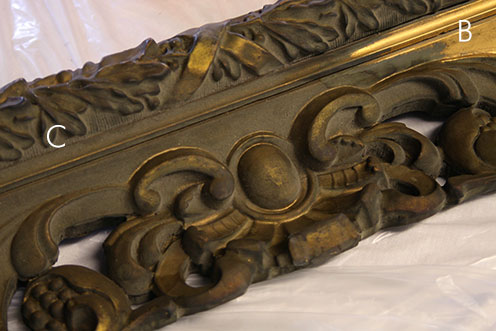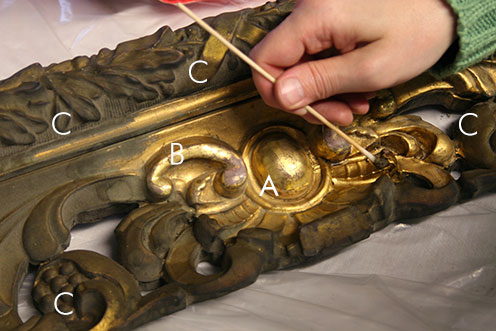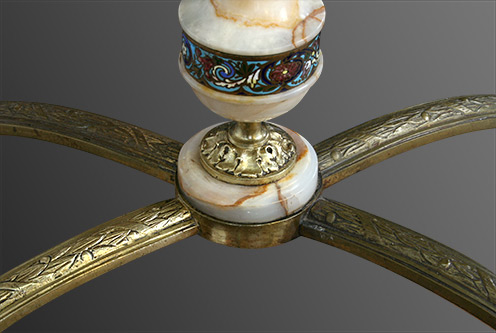Care and Maintenance of Gilt Objects
Gilt, or golden colored objects, can be beautiful and unique but also extremely fragile. They can last virtually forever or be damaged or destroyed in an instant. Totally impervious to light, chemicals, and time or wiped away with the briefest exposure to water. They are thoroughly understood by few and compromised by many.
Gilt objects are created by using various karats of gold leaf, metal leaf (primarily bronze), or various types of “gold” paint. They can be plated, water or oil gilded, and painted. Plating can be done using many methods from traditional ormoulu, using mercury and heat, to various electrically induced coatings. Water gilding uses water soluble animal based protein glues while oil gilding can be applied using everything from traditional primarily linseed oil based sizing to a variety of modern sizings that can consist of many different synthetic materials. “Gold” paint can be pigmented with easily tarnished bronze powder, non-tarnishing mica powders, or in extremely rare cases actual gold powder, that are mixed into virtually any type of clear coating.
I hope you are beginning to understand that gilt objects are not a homogenous or easily defined category. Not only are gilt objects made by using many different materials and methods, one object will often be gilt using a mix of more than one of these materials and methods interspersed and overlaid. On top of this, all of these different materials and methods are often damaged by completely different materials and type of exposures. Adding one more layer of complexity is that different gilt coatings will then be covered with a variety of protective clear coatings that can range from the now extremely rare traditional coating of water based animal protein glue sizing, to wax, to spirit varnishes such as shellac, to nitro-cellulose lacquers, to the extremely varied synthetic chemical based modern clear coatings.
Possible Damage Situations
- Uncoated water gilded gold leaf will not tarnish and is impervious to most chemicals and ultra violet light exposure, but can be scratched by your fingernail and wiped away with one swipe of a water wet cloth.
- A metal substrate oil gilded with gold leaf will be fairly stable under water exposure, but a gesso coated wood substrate oil gilded with gold leaf will not.
- Uncoated bronze leaf and bronze pigmented paints can quickly begin to oxidize and tarnish and in the course of a fairly small amount of time go from a golden color to everything from dull brown to a fairly lurid green.
- Water gilded gold leaf will often not be damaged by the most powerful and crude commercial paint stripper, while oil gilded gold leaf will be quickly damaged or completely destroyed.
- About the only constant in gilt coatings is that due to their thinness they will be damaged by wear and friction.
Appearance
These different materials and methods can also be used to achieve very similar looking finishes.
- A 23kt gold leaf matte coating on gesso can be made to appear very much the same whether it was oil gilded or water gilded.
- Bronze powder pigments and mica powder pigments can appear the same, especially when new.
- When you see the patina of grime and exposure time can add, oil gilded bronze leaf coating can be very hard to differentiate from gold leaf coating.
All of this variety, susceptibility, and fragility means that I, as a professional gilder and gilding conservator, spend a great deal of time trying to repair gilt objects that have been improperly and poorly cleaned, stored, packed and transported. These various types of damage are caused by a variety of types of people from the object’s owners and cleaning staff, to very expensive and high profile moving companies, restorers, “artists”, and even other conservators.
Above: Removing heavy bronze powder coating to uncover matte and burnished 23 Kt gold leaf and carving detail
A: Original burnished water gilding
B: Original matte water gilding
C: Oxidized bronze paint
Care
In answer to the question I am most often asked, “How should I care for my gold piece?” you are almost always better off doing nothing, or the least possible, if you do not already know.
If you have a gilt object that is dusty, you can usually safely dust it by gently using a soft cloth or soft bristled brush. But if you have an antique gilded gesso covered object, where the gesso is lifting or delaminating, both of these methods can cause serious damage by pulling up or dislodging these sections of loose gesso and gilding. Gesso is the white under coating used for much gilding, as well as many paintings, and is basically a very fine type of plaster. Always look for lifting edges or cracking. I have had more than one historical object where I had to spend time on site consolidating and reattaching loose and lifting pieces of gesso before the object could even be transported to my studio for just cleaning.
This is also why a gilded gesso coated object should first be wrapped in plastic before any type of cloth or fabric moving pad is applied. The fabric can catch on those fragile edges of gesso and cause damage. The gesso delamination is primarily caused by the typical wood substrates ability to shrink and swell due to humidity changes and the gesso’s inability to match that movement causing eventual separation.
This plastic covering can also protect an antique gilded gesso coated object if there is moisture exposure. The protein glue in even very old gesso and water gilding can be reactived and softened when wet, and can re-adhere to a fabric covering causing extreme damage. We had a large gilded frame that was crated after being wrapped in fabric moving pads. The crate was exposed to water and by the time the crate was opened, the pads were glued to large sections of the frame requiring that much of the frame had to be re-gilded. Another tip, avoid use of any type of tape on or near gilding. Even the lowest adhesive tape will usually remove gold leaf.
Photo: Before and after cleaning of oxidized copper alloy and ormoulu mounts
Some Cleaning Guidelines
To professionally clean a gilt object can require many different treatments and solutions on even a small piece.
- Determining these proper treatments and solutions on a valuable piece requires a great deal of experience, and often a variety of testing. If you do not have this knowledge you should be very careful; use the barest minimum of moisture, and no commercial cleaning solutions because they usually contain a variety of chemicals, and always test first on the least prominent part of the object.
- The safest general method is using a clean white cotton cloth, cotton balls, or q-tips, and the barest amount of clean, cool water. Wet the cleaning material with water and dab it off on a dry piece before cleaning so there is no excess moisture. Even the most careful repeated cleanings can remove the extremely thin gold leaf just by friction, so gilded objects should not be regularly cleaned. Would you rather have a dust and grime free object with no gold or a gold covered object with some dust?
- Check any gold leafed frame containing a mirror or glass covered artwork and almost all will have very little if any gold leaf on the edge nearest the glass. This is because that edge is also rubbed during the repeated cleaning of the glass with cleaner. To avoid this, use a piece of thin cardboard held up against the gilded surface so your cleaning cloth is only rubbing on the glass.
If you have a gilded object that has been damaged be very wary of most touch-up or repair materials. Virtually every “gold” paint sold in hobby, hardware, or art supply stores are bronze powder pigmented. It will look shiny and gold to start with, but unless it is coated to protect it from oxygen exposure that will rapidly change. Almost no “gold” paint has actual gold in it because it is cheaper to use actual gold leaf, both because of the thinness of the leaf, and you achieve a higher quality resulting finish. Unless you completely choke at the price of “gold” paint, I guarantee you there is no actual gold involved. If you need a gold colored paint make sure it contains a non-tarnishing mica powdered pigment from a reputable gilding supply company such as Sepp Leaf Products, Inc. in New York City.
To summarize, if you have a gilded object, especially if it involves actually gold, that gilding will almost certainly outlast you if left alone. Two things can cause this not to happen. One, the substrate that the gilding is applied to can be damaged or improperly cared for to such an extent that it falls off, carrying the gilding with it. An example of this is a water gilded gesso coated wood object that is exposed to rapid or repeated humidity changes causing delamination and loss if the gesso and gilding. Two, the gilding can be removed by either the friction of wear or repeated and improper cleaning.
My advice, if possible, leave your gilding alone except to appreciate the most uniquely beautiful and most noble of metals, it is an element after all. If it needs to be repaired or cleaned, please call me.
Bart Bjorneberg, Bernacki & Associates, Inc.
312-243-5669
We had a large gilded frame that was crated after being wrapped in fabric moving pads. The crate was exposed to water and by the time the crate was opened, the pads were glued to large sections of the frame requiring that much of the frame had to be re-gilded.
The fibers of the blanket had caught
sections of the rosette corner blocks and been pulled away from the substrate.
Along the lower sections on the outside face of the frame mold had begun to grow.
Small pieces of ornament, gesso and gilding were entangled in the blanket or lay at the bottom of the crate.
The gold leaf supplied by Wehrung & Billmeier Gold Leaf Company from Chicago, Illinois was applied to the areas of loss.
The restored mirror was secured in the custom built crate.













